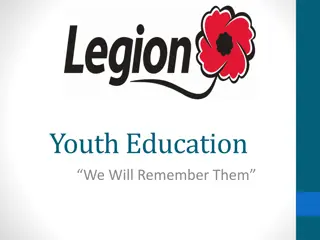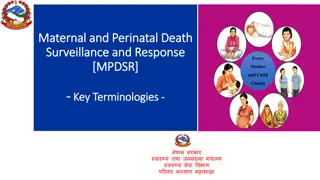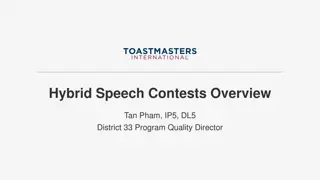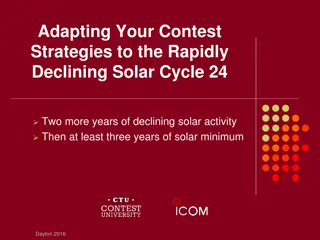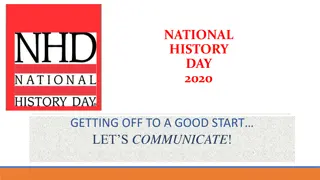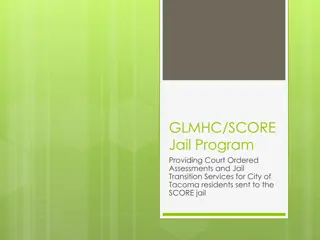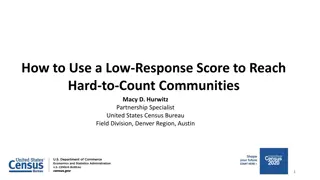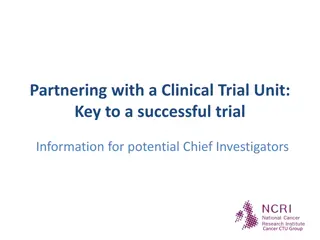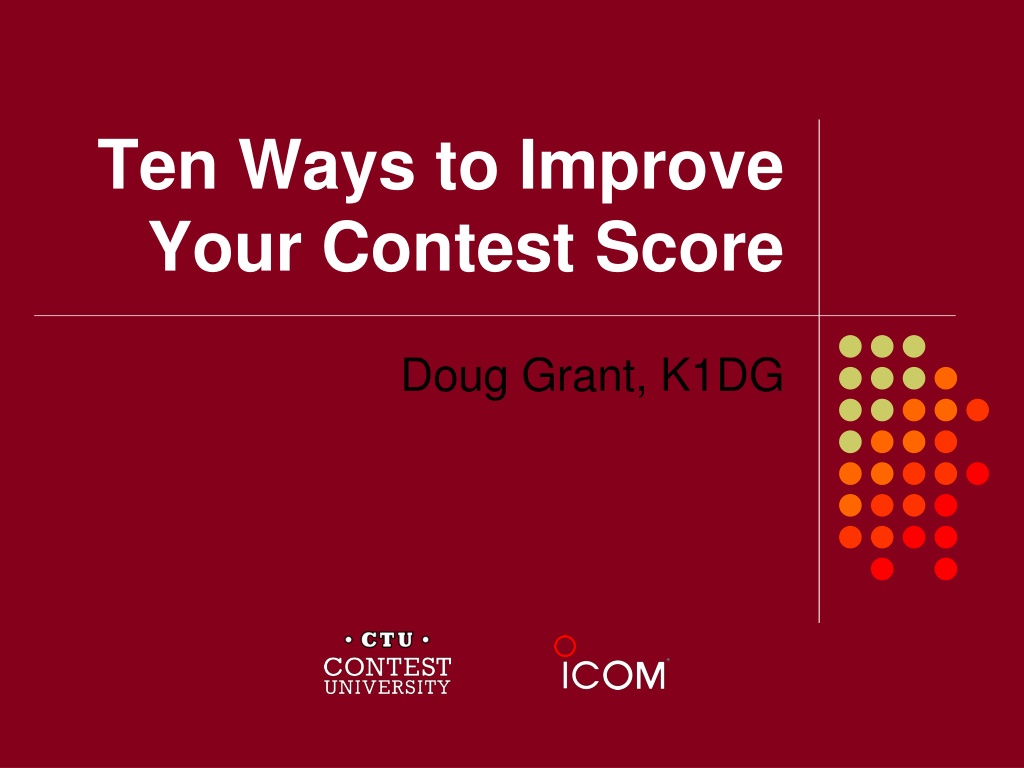
10 Ways to Boost Your Contest Score and Performance
In "Ten Ways to Improve Your Contest Score" by Doug Grant, K1DG, various tips and strategies for enhancing your contest results are outlined. The author covers topics like upgrading equipment, optimizing station setup, joining clubs, using clusters, and attending events like Dayton/CTU. The discussion also delves into the impact of factors such as new radios, amplifiers, antennas, and QTH changes on contest scores. Real-world examples and data comparisons shed light on how these adjustments can make a difference in your performance.
Download Presentation

Please find below an Image/Link to download the presentation.
The content on the website is provided AS IS for your information and personal use only. It may not be sold, licensed, or shared on other websites without obtaining consent from the author. If you encounter any issues during the download, it is possible that the publisher has removed the file from their server.
You are allowed to download the files provided on this website for personal or commercial use, subject to the condition that they are used lawfully. All files are the property of their respective owners.
The content on the website is provided AS IS for your information and personal use only. It may not be sold, licensed, or shared on other websites without obtaining consent from the author.
E N D
Presentation Transcript
Ten Ways to Improve Your Contest Score Doug Grant, K1DG
Ten ways to improve your contest score 10. New radio 9. Amplifier 8. New antennas 7. Move 6. Second radio 5. Join a club 4. Go to a multiop 3. Use the Cluster 2. Go to Dayton/CTU 1. THE BIG SECRET
First cluster of improvements Tangible improvements 10. New radio 9. Amplifier 8. New/better/more antennas 7. New QTH All of these are ways to increase your score, but maybe not the way you think
10. New Radio IMHO, this is the least useful improvement Most $1000+ radios from the past 10 years provide adequate performance and features IMD DR >70 dB SSB, >80dB CW sufficient (NC B) Benefits of a new radio It gets you more interested & on the air more You enjoy it more & get on the air more
9. Amplifier 8. Antennas 7. QTH All are ways to add dB How much is 1 dB worth in score? How much does a dB cost? Amplifier dB Antenna dB QTH dB If the goal is increasing score, where do you spend the money?
Score increase vs. dB Prior to 2014, N1UR always operated LP Good antennas, hillside W1 QTH Switched to HP in 2014 Did it help his score?
Is N1UR Really LP? 2013 CQWW CW RBN data
N1UR SOLP vs the Top SOHP, CW 12000000 200% 180% 10000000 160% 140% 8000000 120% 6000000 100% 80% 4000000 60% 40% 2000000 20% 0 0% 2008 2009 2010 2011 2012 2013 2014 2008 2009 2010 2011 2012 2013 2014 N1UR as % of top Top % ahead of UR N1UR Top HP When N1UR added an amplifier (12 dB), he picked up 120 of those percentage points!
N1UR SOLP vs Top SOHP, SSB 350% 12000000 300% 10000000 250% 8000000 200% 6000000 150% 4000000 100% 50% 2000000 0% 0 2008 2009 2010 2011 2012 2013 2014 2008 2009 2010 2011 2012 2013 2014 N1UR as % of top Top % ahead of UR N1UR Top HP On SSB, adding the amplifier closed about 100 points of the 120 % gap Normalized score increase was 73% 6%/dB
Does it hold for other LP-HP comparisons? Compared Top 5 QRP, LP vs top 5 HP Calculate % score increase vs. dB For CW, ~12% per dB (range: 10.3-15.1) For SSB, ~15% per dB (range: 11.3-17.7) May be closer to the 6%/dB figure, since many LP stations have lesser antennas than HP
From QRP to LP to HP No RBN data (QRP guys don t call CQ!) 5 spots total in DL for top 5 QRPs, all bands) HP scores typically 1000% (CW) to 1500% (SSB) higher than QRP 1500W is ~25dB above 5W Most QRP guys do not have big antennas another 10dB of QRPness maybe? If linear, 30%(CW) to 40%(SSB) per dB increase
9. Add an amplifier (LP guys only) Cost: Used SB220 $500 $10k for auto-everything Use $2500 100W to 1500W is 11.6 dB Cost per dB: $200 (only $43 with SB220) Score improvement should be ~80%; $31 /% KPA500 vs. 1500W: 4.77 dB; ~30% score increase
For HP entrants More than 1500 W is against the rules Adding 10 dB is very expensive Tubes >$1000 Electrical service to the shack is expensive Coax, connectors, filters all get complicated Damage to reputation Don t do it!
8. Antennas A very mixed bag of bang-for-buck Gain is expensive after a while -wave vertical: 1.77 dBi FS, 5.15 dBi over perfect ground, 0 dBi over average ground 40M dipole used on 15M: 2.8 dBi 80M dipole used on 15M: 4.7 dBi 3 element 15M beam: 7.44 dBi, $500, 2.7m boom, 12 lb 4 el: 9.01 dBi $750, 5.4 m, 20 lb 5 el: 9.1 dBi $900, 6.2m, 25 lb 5 el: long boom 10.1 dBi $1050, 8.5m, 28 lb 6 el: 10.9 dB $1500, 11.3m, 51 lb 7 el: 12 dBi $2300, 17.6m, 78 lb
The K1AR Story Excellent scores with just a dipole AR is one of the best operators ever NH QTH 1500W output
80M Dipole vs. Tribander (10M)
Antenna dB/$ dBi 14 6 el beam 12 10 8 3 el beam 6 4 2 0 $0 $500 $1,000 $1,500 $2,000 $2,500 4dB = 40% score increase, $1000 $25/%
If you already have a beam Assume starting point of 40-foot tower with 3- element tribander Move to 80-foot tower, stack two 4-element beams Cost, comparison of patterns, gain
Low band improvements are hard 40M Start with inverted Vee at 60 feet (1.6 dBi FS, 6 dB over real ground but very high angle) Move to 2-el shorty beam at 60 feet ($1000 + rotator, gives 5-6 dBi gain in FS, 9-10 over real ground) 4 dB for $1000 = $250/dB; 25% increase in score Probably much better due to lower angles Vertical or sloper array 80M/160M Start with inverted Vee at 60 feet Consider half-sloper or vertical array Verticals need lots of radials Arrays need phasing boxes, build or buy Adding a Beverage to receive better is <$50
Feedline improvement Assume a tribander at 60 feet, 140 feet from the shack, fed with RG8X Loss of 200 of RG8X on 10M: 4 dB Replace with 200 LMR400, loss: 1.6 dB Gain 2.4 dB for $180 = $75/dB Equivalent to raising power by 1.7x AND helps on receive 24% score increase Replace with surplus CATV line, loss of 0.4 dB Gain 3.6 dB for $? Equal to raising power by 2.2x OR
Getting 3.6 dB additional gain on 10M 3-el 10M yagi: 7 ft boom, $300, 7.5 dBi 6-el 10M yagi: 28 ft boom, $1000, 11.1 dBi Spend $180 (or scrounge) better coax or spend $700 on a bigger beam If you already have a 6-element yagi, the next 3 dB will cost a lot more!
7. Move Complicated and expensive Can be effective Hilltop or oceanfront vs valley W1 vs. Black Hole (NM/WTX/KP4 vs W1 for SS)
7a. Virtual Move Remote station This is now practical RHR, others Roll your own
6. Add a Second Radio Don t try SO2R until you are really good at SO1R please! - K5ZD SO2R station construction is harder than Multi- Multi - KL7RA Adding a second radio only adds ~10% to a DX contest QSO total, maybe 20-30% to score It allows you to know what is happening on the other bands
5. Join a Club Chose the right club or start one! Learn from the other guys Exchange rate sheets Do for others and let others do for you B. Dylan
4. Go to a Multiop Most multiops are well-equipped See what it is like to use the Big Iron See how other ops play the game Learn some best practices in station design and construction
3. Use the Cluster (sigh) It will add 20-30% to your score BUT You will not learn anything if the Cluster does the work for you Don t let the Cluster distract you Don t believe all the spots it can make your score go DOWN
The Cluster Makes Mistakes! If you worked all the calls on these screens you would have a negative score!
2. Go to Dayton (and CTU) Meet people Learn from the pros Ask questions Pay attention
AND THE NUMBER ONE WAY TO IMPROVE YOUR CONTEST SCORE >>>> THE BIG SECRET <<<<
1. There is no secret! Get on the air a lot Learn the bands and your station capability Practice calling in pileups to hone your timing LISTEN! Run any time you can get familiar with callsigns (improve your vocabulary )
The Big Myth I yam what I yam, and that s all what I yam Popeye the Sailor Can t run, can t jump. scouting report on Larry Bird "Can't sing. Can't act. Balding. Can dance a little. RKO screen test of Fred Astaire
Outliers (Malcolm Gladwell book) Cites Ericssons 10,000 hour rule Beatles (1200 live performances in Hamburg 1960-64), Bill Gates (had access to a computer at age 13) 10,000 hours of deliberate practice required for mastery Deliberate practice is not always enjoyable The top contest operators don t have bigger or more sensitive ears, springier fingers,
How did the top operators get there? Giftedness researchers have long debated whether there is empirical evidence to support a distinction between giftedness and attained level of achievement. With the exception of fixed genetic factors determining body size and height, we were unable to find evidence for innate constraints to the attainment of elite achievement for healthy individuals. K. A. Ericsson et al, Giftedness and evidence for reproducibly superior performance: an account based on the expert performance framework , High Ability Studies Vol. 18, No. 1, June 2007, pp. 3 56,
Two more factors, from recent research Starting young All other factors being equal, those who started younger were higher achievers at the elite level Probably related to development of working memory capacity, the ability to remember a set of objects while engaged in another task Grit The unique blend of IQ and EI that results in persistence The desire and passion to get better drives the willingness to spend so many hours practicing a skill.
However The 10,000 hour rule applies to the World- class top performers You can get pretty good in 20 hours Josh Kaufman s rules for learning: 1. Deconstruct the skill into smaller parts 2. Learn enough to self-correct 3. Remove barriers to practice 4. Put in the full 20 hours overcome the initial frustration barrier
Contesting is a personal endeavor Some do it to compete Build station Improve station Operate a lot Some do it just for fun Part-time operation Pick up new countries, etc. Take what they can get
Some do it for both Most games are more fun when you develop a high level of skill Whatever your goal, have fun!



